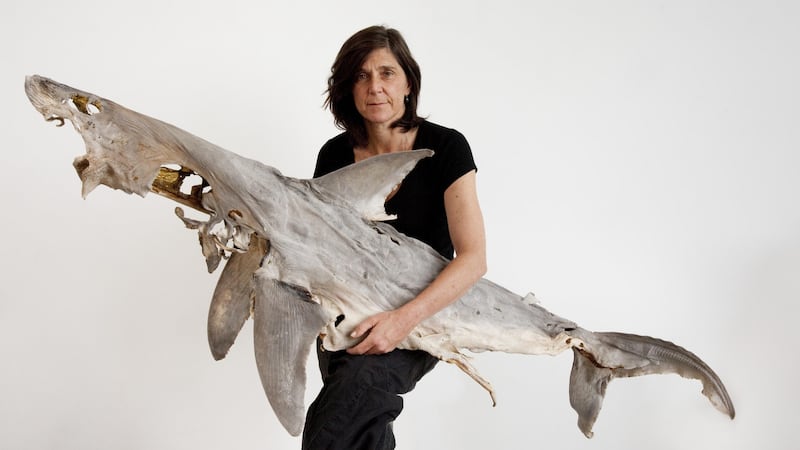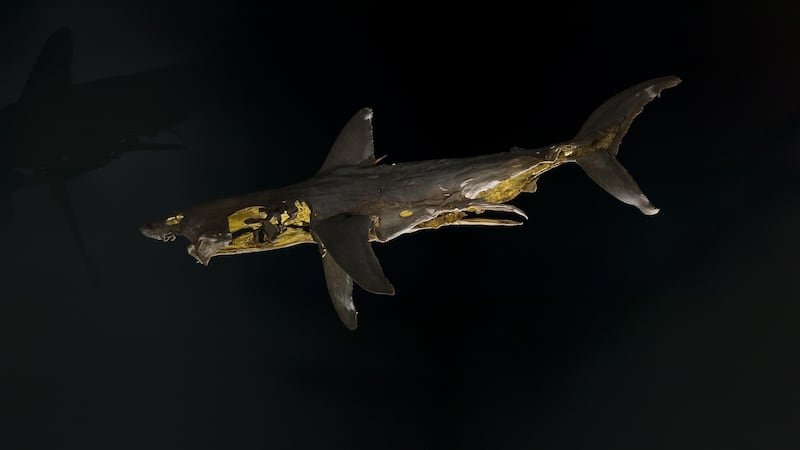“We need to get to know sharks better,” says artist Dorothy Cross. “There are 35 different types swimming in Irish waters, and yet we’re largely oblivious. These beautiful, svelte creatures have been on this planet for over 400 million years, and are so perfectly formed that they have remained largely unchanged for the last 100 million years.”
Her introduction to the world of sharks was a typical one of fear – while living in California and reading of attacks by great whites in San Francisco Bay. But once she learned to scuba dive it quickly turned to fascination.
"The first dive I ever made was with hammerheads in the Galápagos, and it was an extraordinary experience: realising I was in their territory and seeing how calmly they observed me, these exquisite, amazing creatures."
Winter Nights
Since then she has dived with different types of shark all around the world, and spent time with shark-callers on the island of New Ireland off Papua New Guinea, where local men ritualistically sing to lure sharks up from the deep, believing their ancestors guide the shark to be caught to feed the community.
“The shark-caller sleeps in isolation and abstains from many things before heading out alone on a small dugout canoe to fish. When he catches a shark he sounds a conch, and the villagers rush to the shore to share the animal,” says Cross. “The caller gets the liver and the fins, and everyone cooks the meat together on hot stones in pits.”
Closer to home we are all gradually becoming more accustomed to sharks, with the increased sightings of basking sharks along the west coast, and even a confirmed report of a smooth hammerhead shark 160km southwest of Ireland on the continental shelf edge last year.
This was the first time the species has been seen in Irish waters, and with its classic hammer-shaped head and tall, slender dorsal fin it's unlike anything encountered here before. This discovery followed closely on the announcement by the Irish Marine Institute of a deep-water nursery of blackmouth catsharks 300km west of Ireland, which they spotted while surveying with a remotely operated vehicle.
Scientists believe that up to 10 new species of shark may become common in Irish waters as sea temperatures rise in coming decades, including blacktips, sand tigers and longfin makos. The hammerheads too will be more frequent – these placid monsters that have never killed a human and give birth to live young in the shallow sandy waters near the Caribbean and West Africa. Many of these species are facing increasing threat from over-fishing, plastic waste and climate change. Some are facing outright extinction.
The hammerhead is listed as “vulnerable” on the International Union for Conservation of Nature (IUCN) Red List of Threatened Species, and is being increasingly targeted for the shark fin trade. The porbeagle and angel shark found in Irish waters are both on the “critically endangered” list, while the leafscale gulper shark and basking shark are classified as “endangered”.
Symbiotic
Cross’s lingering memory of her time in New Ireland in 2006 was how the silky, mako and oceanic white tip sharks were becoming worryingly scarce due to increased fishing by Malaysians and Chinese, who harvest their fins for traditional cures and shark fin soup.
“The ancient way of life for the New Irelanders is coming to an end,” says Cross. “What was a balanced life, symbiotic with what nature provided, is becoming extinct.”
The fact that shark fishing is becoming an increasingly popular tourism activity in Ireland is particularly upsetting for Cross. It's a key feature offered all along the Wild Atlantic Way from Cork to Donegal.
“I wish these people realised how important sharks are for the biology of the ocean,” says Cross. “They are top of the food chain and so everything beneath relies on them. They are vital to ensuring ecological balance, yet they are under such threat from anglers.”

Ireland is not currently involved in shark finning, but we do catch a significant amount of sharks for sport – it is “catch and release” and the fish are tagged as part of a marine programme overseen by the Irish Central Fisheries Board.
Yet many sharks still end up with barbed hooks corroding in their bodies, and long lines of broken tackle trailing from their mouths.
Deep-sea angling enterprises along the west coast of Ireland claim to have landed more than two dozen blue sharks in one day with average catches in double figures. During the season almost every shark fishing trip is successful, but luring and landing a blue shark that can weigh up to 65kg or a porbeagle that can reach 100kg without doing harm is very difficult.
“What pleasure could anyone get from traumatising an animal for hours on the end of a hook that is probably lodged in their stomach?” asks Cross.
Their release is of no real solace to her, as her brother, zoologist Prof Tom Cross, suggests that if the sharks are “played” too long on the line their muscles build up an excess of lactic acid that can prove fatal, or they can bleed to death after release.
That said, sharks that have been caught and tagged in Irish waters have been recaught as far away as the Cape Verde Islands, but the impetus is to bring them aboard and tag and release them as quickly as possible.
Shark’s heart
As an artist Cross has done more than most to highlight the plight of sharks in works like Relic (2009), which consists of the skin of a porbeagle shark she bought from a fishmonger in the English Market in Cork that was then lined with 14 carat gold, or Shark Heart Submarine (2011), which has a preserved shark’s heart encased in a model of a nuclear submarine and is now in the permanent collection of the National Gallery of Ireland.
"I've used blue sharks, basking sharks and porbeagles in the work. All were washed up dead on the coastline or caught by fishermen when shark was still allowed to be sold to eat in Ireland. Gladly that is no longer the case. When I went to Trinity College to meet the queen of England I had the skin of a basking shark defrosting on the back seat of my car."
Cross acknowledges that some of her art could be regarded as pro-shark polemic, although works such as Basking Shark Currach (2013), which consists of the skin of a basking shark hand-stitched on to the skeleton of a small currach, or Everest Shark (2013) are important pieces in their own right.
It gave her particular pleasure to have the artwork Relic, featuring the gold-lined porbeagle, displayed in the Bloomberg SPACE in London, a centre of international currency speculation. "The currency traders would have recognised the value of the gold, but probably not that of the poor shark."

It is regrettable that Hollywood has commodified the shark; making it a crass motif to signal fear and threat. “They now epitomise the human fear of our own mortality,” says Cross. “We are all going to die, but unlikely from an accidental shark attack.”
She acknowledges that sharks, in rare circumstances, can be dangerous, but attacks occur largely through misidentification. “We appear from below like their food – like seals and small fish. Their preferred food is blubbery and soft. Our bony bodies are not palatable.”
Her desire is to see Irish people becoming guardians of our sharks, as we are for dolphins and whales.
“We need to start appreciating the mystery of them; the fact that scientists had no proof that they sleep until recently, or that no human has ever seen a great white mating.”
The fact that they disturb us is valuable, she believes – “it’s good for us to be shaken out of our complacency”.
“I like that both art and sharks are elusive and disturbing, navigating between the seen and unseen. They are both revelatory and essential.”
For more on sharks in Ireland: iwdg.ie baskingshark.ie










